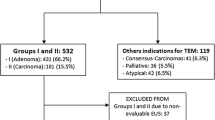Abstract
The purpose of this study was to evaluate the accuracy of preoperative staging by endorectal ultrasonography (EUS) and its contribution to treatment of early stage rectal cancer (ESRC). The results of EUS for 154 consecutive patients with ESRC (pTis to pT2) were compared prospectively with histologic findings, assessed according to the TNM classification. Results of treatment selection and long-term outcomes were analyzed retrospectively. There were 35 patients histologically staged as pTis, 8 as pT1-slight (invasion confined to the superficial one-third of the submucosa), 37 as pT1-massive (invasion extending to the deeper submucosa), and 74 as pT2. The equipment used was an echoendoscope GF-UM2 or GF-UM3 (Olympus, Tokyo, Japan). Sensitivity/specificity/overall accuracy rates for detection of slight submucosal invasion, massive submucosal invasion, and muscularis propria invasion were 99%/74%/96%, 98%/88%/97%, and 97%/93%/96%, respectively. Incidences of lymph node metastasis in pTis, pTis to pT1-slight, pT1, pT1-massive, and pT2 cases were 0%, 0%, 18%, 22%, and 30%, respectively. Incidences of lymph node metastasis in ESRCs staged by EUS (u) as uTis, uT1-slight, uT1-massive, uT2, and uT3 by EUS were 0%, 0%, 26%, 36%, and 64%, respectively. Sensitivity, specificity, and overall accuracy rates for detection of positive nodes in overall ESRCs were 53%, 77%, and 72%, respectively. Of the 43 patients with pTis to pT1-slight tumors, 22 underwent endoscopic polypectomy or local excision, 20 radical surgery, and 1 radical surgery after endoscopic polypectomy due to vascular invasion. All these patients are alive and all but one (who refused radical surgery due to vascular invasion after local excision and developed liver and lung metastases) are disease-free. Of the 37 patients with pT1-massive tumors, 34 underwent radical surgery and 3 transcoccygeal segmental resection. All these patients are alive disease-free except for one who died of peritoneal carcinomatosis after radical surgery. All patients with pT2 tumors underwent radical surgery. The overall 5-year survival rates for pTis, pT1, and pT2 cases were 100%, 98%, and 97%, respectively. EUS is an accurate method for evaluating invasion depth in ESRC. Patients with uTis or uT1-slight tumors staged by EUS are at low risk of positive nodes and good candidates for endoscopic polypectomy or local excision. Those with uT1-massive or uT2 lesions should be treated with a radical operation because of the high incidence of positive nodes.
Similar content being viewed by others
Author information
Authors and Affiliations
Additional information
E-pub: 3 July 2000
Rights and permissions
About this article
Cite this article
Akasu, T., Kondo, H., Moriya, Y. et al. Endorectal Ultrasonography and Treatment of Early Stage Rectal Cancer. World J. Surg. 24, 1061–1068 (2000). https://doi.org/10.1007/s002680010151
Published:
Issue Date:
DOI: https://doi.org/10.1007/s002680010151




